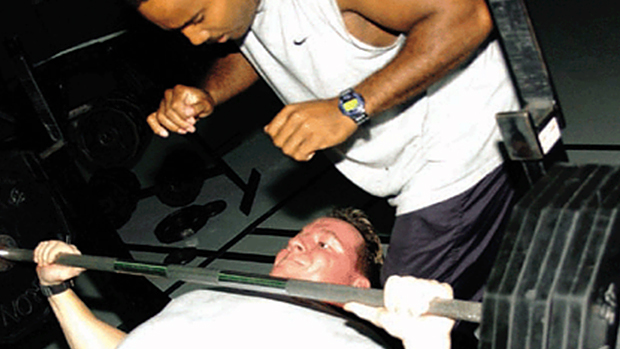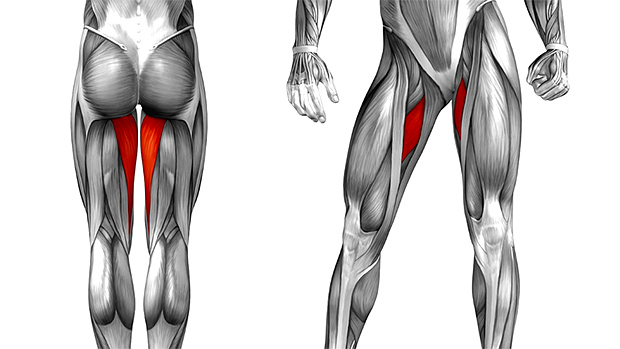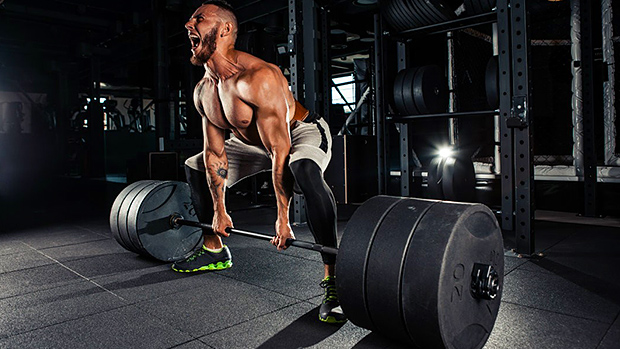AlwynCosgrove's original "My 5 Ah-Ha Moments" got me thinking: what are my top 5? What are the most influential events in my life as a coach and trainer?
The following are the top five defining moments in my coaching and athletic career. Enjoy!
1 – Being strong is cool.
At a young age in the iron game, I was surrounded by people who drank the pro-bodybuilder Kool-Aid. I followed body part splits, never squatted ('cause it hurts your knees), and never deadlifted. You know, 'cause it hurts your back.
Unfortunately, I followed geek-style training for quite some time.
It took me a while, but I eventually figured out being strong is cool. I never liked the idea of having big, showy muscles that weren't capable of doing great feats of strength. While I didn't have any desire to look like a fat, bloated powerlifter, I didn't want to look like a collection of body parts like many of today's pro bodybuilders, either. I'm still a huge fan of the old-school bodybuilders; they trained the right way, and it was reflected in both their strength and their physiques.

Once upon a time, bodybuilders who looked strong actually were strong.
When I started my masters program at Ball State, I knew that all I wanted to do was work with athletes as a strength coach. I enjoyed my time there as much as anything, as it blended my love of iron and athletics into one kick ass job.
The problem was this: I was really weak. Not a little weak, really weak. I didn't necessarily look weak; after all, I'd been hitting the iron for at least 6 years by this point in time. But especially when it came to my lower body, I needed a serious overhaul.
There was only one solution: grow stronger.
I joined the powerlifting team and slowly added pounds to the bar. Needless to say, it wasn't a meteoric rise, but over the course of 5 years I put 450 pounds on my total.
But even more important than the strength I gained in the gym was the strength I gained outside of it, and the relationships that I developed from that training. I'm not going to name drop, but I've had the privilege of hanging out and chatting with some of the strongest powerlifters and coaches in the United States.
It's not the solution to every problem, but more times than not you can do a lot worse than simply getting stronger. Whether you want to improve your physique or improve your sporting performance, improving your strength can take you pretty damn far.
2 – Before you can be strong, you must be weak.
Before I set out on my journey to grow stronger, I had to accept one cold, hard truth:
Before you can be strong, you must first be weak.
My first two years in the sport saw me net the typical newbie gains, especially in my deadlift. However, my bench and squat lagged behind because I wasn't willing to admit that I needed a total overhaul with regards to my technique and approach to training.
To do this, I had to admit to myself that I was weak. Truth be told, I wasn't a good squatter or a good bench presser. But I also accepted this weakness for what it was: a temporary state.
As a powerlifter, technique is everything. I have seen guys with freaky strength get beaten, time and again, by a lifter who is methodical in his approach to technique. In the squat, the simplest change I made was to move my hands in on the bar.
I had a bad habit of getting caved over in the hole, so simply moving my hands in improved my thoracic extension, forced my chest out, and made me much tighter overall. I went from missing several reps in any given workout to missing (at most) 2-3 reps in a year. If your technique is lagging in the squat, be sure to check out my 10 Tips for Flawless Squattin' and my 6 Tricks for a Sexy Squat articles.
In the bench, a quick change to my set-up made a profound difference. While the actual execution of the lift wasn't that bad, I left pounds on the bar because I was loose as a goose in my set-up. To correct this, I really focused on getting tight both in my lower and upper body. I dug my upper back into the bench, and tucked my legs back underneath me so that I could use leg drive to help me push through the sticking point. I outlined my approach to setting up in the bench here.
The thing I always tell my clients and athletes is this: I don't care where we're starting from. Whether you're squatting 600 or benching 150, your current state is irrelevant to me. What I'm concerned with is your drive and desire to achieve your goals. If you're willing to dedicate your time and energy to becoming a better lifter, then you're exactly the kind of person I want to work with.
3 – Corrective exercise and therapy are important.
In the winter of 2003, my thought process as a coach was changed forever.
Being your typical meat head coach I was very comfortable teaching lifts, mobility drills, and getting athletes diesel. I couldn't care less about rehab and therapy. One of the things I would do (and still do today) was to rate myself as a coach on a scale of 1-10. Obviously, the things I was most focused on were my ability to teach strength training exercises, speed development, rehabilitation, etc.
I also clearly remember that I gave myself either a 1 or 2 at rehab. Basically, I sucked at it. Meeting Craig Liebenson changed all that.
I knew coming out of college that to be a good coach, I had to have a basic understanding of therapy and rehabilitation. I had no desire to become a physical therapist, but to be really good at this job you need to have an understanding of what everyone brings to the table.
I had the pleasure of spending one day with Craig and started learning his system for rehabilitating his patients. Needless to say, it was mind blowing. His understanding of posture, assessment, and movement were fascinating to me.
For the next two and a half years at the Athletic Performance Center, I did more than my fair share of rehabilitation and corrective exercise. I also studied all the therapies I could; foam rolling, various stretching protocols, activation/motor control drills, etc. Over the course of those two and a half years, I went from knowing nothing about rehab and therapy to being quite comfortable with it.
Today, I'm probably most well known within this industry for my ability to blend "corrective" exercise with strength and sports performance training. My niche is to take the beaten up lifter or athlete and get them back to the top of their game. In a lot of ways, that one day has formed the rest of my life and coaching career.
Thanks, Craig.
4 – "Movement quality" is more important than just mobility.
When Eric Cressey and I started outlining the key concepts and exercises for our Magnificent Mobility DVD, I started to have a genuine appreciation for how integral mobility is. In a lot of ways, having good mobility is key to your vitality in life. Have you ever seen an older person or ex-athlete who has been riddled with injuries? Not only have they been robbed of their mobility, but their vitality and zest for life has decreased as well.
While creating the script, I started to realize something else: it's not just mobility that's important, but rather the quality of said movement as well. If you're doing a squat or lunge with terrible form, you're not really getting the most out of it. So to take the idea a step further, movement quality may be a better term. This would include not just mobility but motor control, symmetry of movement between sides, and the efficiency with which you can complete said movements.
After all, just completing a movement is one thing, but completing it with flawless technique and the appropriate muscles working can be entirely different. One of our goals of training should always be to reinforce efficiency in our programming.
5 – Rethinking core training.
A few years ago, I wrote my original core-training piece for T-Nation, called 21st Century Core Training. The title was actually facetious: after all, the piece was filled with old-school exercises that had been around for decades.
Fast forward to 2006, when I spoke at a seminar in LA. By this time, I'd totally revamped the core training exercises that I was using in my programs. The goal was no longer to promote movement around the lumbar spine, but rather to prevent it! What happened between those two times?
I did my best to educate myself on the core: how to train it, the functional anatomy, etc. I read up on authors far more experienced than myself such as Dr. Stuart McGill, Shirley Sahrmann, Michael Boyle, and Nikolai Bogduk. All these authors reiterated (in some form or fashion) that the lumbar spine was not built for mobility. Here are some examples:
- Stuart McGill has discussed numerous times how repeated flexion and extension of the lumbar spine was a recipe for herniating a disc.
- Sahrmann and Bogduk discuss in their respective books that the lower thoracic and lumbar vertebral intersections only allow for 0-2 degrees of rotation per segment.
Taking it a step further, if we examine the musculature surrounding the core, it's a huge cross-hatched web. The rectus abdominus runs vertically, the transverse abdominus runs horizontally, and the internal and external obliques run at diagonals perpendicular to each other.
Now, I may not be the brightest bulb when it comes to structural engineering, but I do know that if I want to make a stable base, I'm going to cross-hatch the foundation to maximize stability. Not surprisingly, this is exactly what our body has done to prevent excessive movement around the lumbar spine!
Whether your goal is to squat or deadlift more weight, play better golf or stop persistent low back pain, training your core for stability can improve your performance while reducing the likelihood of injury.
Summary
So there you have it: the 5 most influential moments for me as a coach. As the Grateful Dead once said, "What a long, strange trip it's been." Maybe, but the journey and path that I've followed have made me the coach that I am today.
And I wouldn't trade that for anything.





